Poll
 | 16 votes (80%) | ||
 | 1 vote (5%) | ||
 | 3 votes (15%) |
20 members have voted
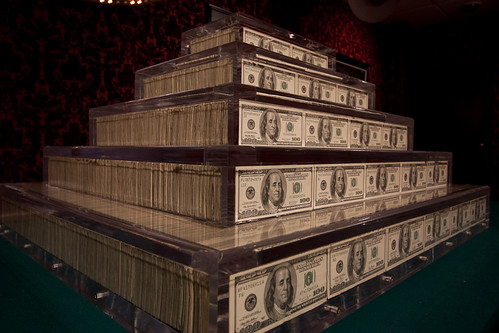
There are 20, hundred dollar bills facing the front. I will assume there are another 20 in the back. This means $4,000 is actually shown, with the other $996,000 supposedly tucked in-between. Back in the day, it was 100, $10,000 bills. It was neat to see up close, and it was all visible:
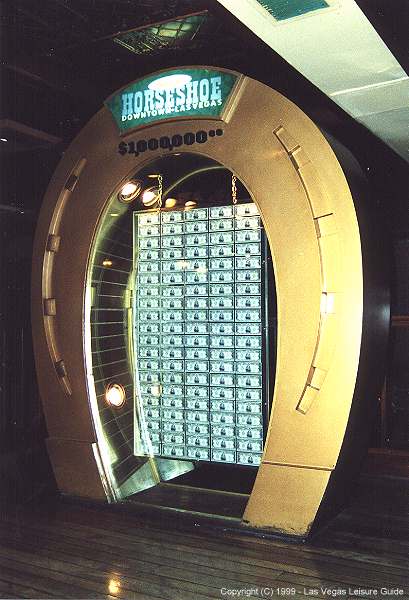
Given the utility of the money that drove the owners to take down the original Million, I am suspicious that the display really contains $1 million in USD. What do you think is in the middle, sandwiched between the hundreds in the front and back?
Quote: AyecarumbaGiven the utility of the money that drove the owners to take down the original Million, I am suspicious that the display really contains $1 million in USD.
People regularly sell $1000 bills for $2000 or more on e-bay. There is a $10,000 banknotes on sale now for $89,000 (no takers), but they are worth several times their face value. So the original display was worth far more than $1 million. Jay Parrino, who bought the display would only say that he paid less than $10 million.
The new display is 79,100 banknotes:
$270,000 in $100 banknotes weighing 6 pounds
$688,000 in $20 banknotes weighing 76 pounds
$42,000 in $1 banknotes weighing 92 pounds
So the whole display with acrylic container is over 200 pounds (174 pounds in banknotes), making it difficult to run away with, but still easily handled to put it into storage.
The loss of roughly $1000/week in interest is reasonably paid back in customer interest in the display.
Note: If as a cost cutting measure all of the internal banknotes were replaced with $1 bills, it would still be $83,060 in cash. But I don't think they would stuff it with newspaper as that wouldn't look correct.
Eyeballing that picture, I would say if you stacked up all the bills in the pyramid it would be 45' = 540" high. There would be 540*2*100=108,000 bills in a 540" stack. I assume the visitor can see $100 bills on the back side, accounting for 40 visible $100 bills = $4,000. That leaves $996,000 and 107,960 bills. That would make the average non-visible bill $9.23.
do you always win the charity gumball count where you have to estimate the number of gumballs in a large jar?Quote: WizardA stack of 100 bills is just about 1/2" high. 7/16" if you squash it down hard. Let's just assume 1/2". Each would contain $10,000. It takes 100 bundles to make $1,000,000. So $1,000,000 in $100 bills would be 100*0.5 = 50". You could fit that into two large shoeboxes. Clearly some of the bills in the display are not $100 bills.
Eyeballing that picture, I would say if you stacked up all the bills in the pyramid it would be 45' = 540" high. There would be 540*2*100=108,000 bills in a 540" stack. I assume the visitor can see $100 bills on the back side, accounting for 40 visible $100 bills = $4,000. That leaves $996,000 and 107,960 bills. That would make the average non-visible bill $9.23.
Quote: WizardI assume the visitor can see $100 bills on the back side, accounting for 40 visible $100 bills = $4,000. That leaves $996,000 and 107,960 bills. That would make the average non-visible bill $9.23.
Pretty good guess for eyeball. Using the numbers published in the paper that would be 40 visible banknotes and 79,600 hidden bills with an average value of $12.60 .
Assuming that they put only the $1 bills on the bottom, that would be six rows of 7000 banknotes. Assuming 100 banknotes in 1/2" that is 35" which looks about correct.
If the top is two rows of $100 banknotes that is (1350 -18) per row or less than 7" in length. Also looks about correct.
My guess is levels 2,3 and 4 are all stuffed with $20 banknotes in between.
Good point. So it's all real, just not all Benjamins.Quote: FleaStiffThey use that sum as part of their calculated reserves since it is indeed cash on hand.
Quote: DJTeddyBearGood point. So it's all real, just not all Benjamins.
Benjamins would be about 50" stack weighing 22 pounds. Assuming a briefcase could fit two rows, you could fit $1 million in a standard briefcase.
This display is 400" of banknotes.
The picture also comes with a nice sheet of coupons. I won 80 bucks while earning the needed points for the free shirt, and another 30 on the match play. I have a trip in July (with Vegas noob) and in September (with group of guys, many downtown noobs) and plan to take them both to Binion's because of this display. Mr. Martin is indeed correct that they're probably getting back their 1000/week lost interest and then some. Consider it a marketing expense.
| level | rows | inches/row | inches | banknotes | bill type | pounds | value $K |
|---|---|---|---|---|---|---|---|
| top | 2 | 6.75 | 13.5 | 2,700 | $100 | 5.9 | $270 |
| second | 3 | 8 | 24.0 | 4,800 | $20 | 10.6 | $96 |
| third | 4 | 12 | 48.0 | 9,600 | $20 | 21.1 | $192 |
| fourth | 5 | 20 | 100.0 | 20,000 | $20 | 44.0 | $400 |
| bottom | 6 | 35 | 210.0 | 42,000 | $1 | 92.4 | $42 |
| 20 | 395.5 | 79,100 | 174.0 | $1,000 |
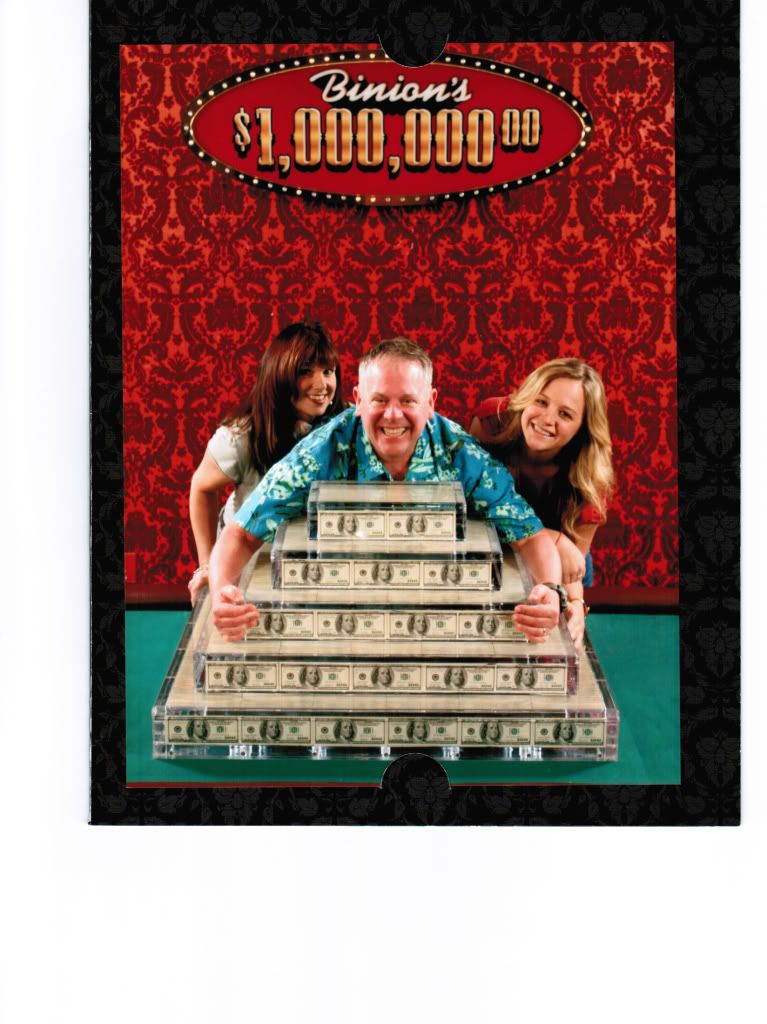
This is one of my FAVORITE pictures from our trip last month.
I LOVE hugging all that money!
And being with my Wife and Daughter!

They need to get some fake bills that you can throw while standing behind the display for your photo.
Right. There is obviously a value to a display that is impressive. A casino would gain nothing by putting green blotting paper inside the stacks or something. Or making it a fake photo opportunity. Or a legitimately correct but unimpressive arrangement of the currency. Its an advertising gimmick and is probably a fairly good "draw" as an attraction in the area. Some think the photo beats out those key chains and fake dice or edge-trimmed card decks. Its a way of the casino getting momentos with their logo on it all over the various hometowns and perhaps into the various hometown newspapers.Quote: DJTeddyBearGood point. So it's all real, just not all Benjamins.
Quote: FleaStiffRight. There is obviously a value to a display that is impressive.

Personally, I would think it would be cooler to have it in a clear acrylic briefcase with all $100 banknotes, with a kevlar strap holding it down to the floor. That way you could pick it up an pose for a picture.
Quote: pacomartinThe new display is 79,100 banknotes:
$270,000 in $100 banknotes weighing 6 pounds
$688,000 in $20 banknotes weighing 76 pounds
$42,000 in $1 banknotes weighing 92 poundst.
How do you know this?
By the way, I had my pictures taken with the 1M (again) before WoVcon today. In my earlier estimates I figured the base was a square. However, when I got up close it was more of a rectangle of about 2x3 dimensions, with the long side facing the camera.
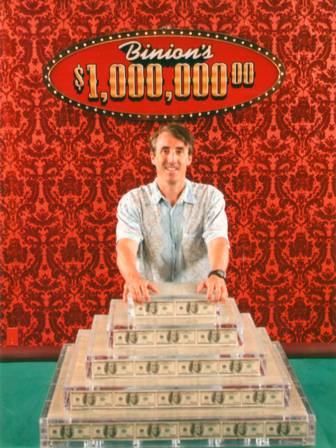
Quote: zippyboyHere is what a TRILLION Dollars looks like.
Nice. Or you could ask Monty Burns if he'll show you his trillion dollar bill...

At the Western I bet that sum would be very securely strapped down. And they would probably have a "toofer" special. Get photographed with the 83.57 and also have your most recent booking photo put into a special photo album display.Quote: Wavy70At The Western you can get a picture with $83.57.
Quote: WizardHow do you know this?
By the way, I had my pictures taken with the 1M (again) before WoVcon today. In my earlier estimates I figured the base was a square. However, when I got up close it was more of a rectangle of about 2x3 dimensions, with the long side facing the camera.
The values were published by Ben Spillman in the Las Vegas Review Journal when the display opened. I did a number of articles with Ben at the time, so I remembered that they were in the LVRJ.
However, he did not say how they were arranged. I based the following table on the assumption that the bottom was full of $1 banknotes, and the top was full of $100 banknotes, with $20's in the three levels in between. I figured it would be easier to audit, but the design may be more complicated. The table is a good first guess.
The table assumed 200 banknotes per inch. But the design looks fairly regular, so they may have packed some more loosely. It does not consider the $4K that is being displayed.
| level | rows | inches/row | inches | banknotes | bill type | pounds | value $K |
|---|---|---|---|---|---|---|---|
| top | 2 | 6.75 | 13.5 | 2,700 | $100 | 5.9 | $270 |
| second | 3 | 8 | 24.0 | 4,800 | $20 | 10.6 | $96 |
| third | 4 | 12 | 48.0 | 9,600 | $20 | 21.1 | $192 |
| fourth | 5 | 20 | 100.0 | 20,000 | $20 | 44.0 | $400 |
| bottom | 6 | 35 | 210.0 | 42,000 | $1 | 92.4 | $42 |
| 20 | 395.5 | 79,100 | 174.0 | $1,000 |
The federal reserve shrink wraps 4,000 banknotes together, in a brick which is one banknote by about 18"-20" in length. They put four bricks together to make a Cash-Pak which weighs about 35 pounds (currency only). That way it is standard carrying weight for one small person. The shrink wrapped bills are a unit of currency. They are not broken up and the bills counted individually (even by machine).
Tom Breitling tells the story at the Golden Nugget about the gambler who came in with 8 bricks of $100 bills in a pillowcase (roughly 70 lbs and $3.2 million).
Quote: pacomartin
Heeeeey! What are you doing looking under my mattress!
lol
Quote: TIMSPEEDHeeeeey! What are you doing looking under my mattress! lol
Production numbers of the $100 banknote are astonishing. The table only refers to the $100 bill which we started producing in mass quantities in 1991, the same year the trade deficit started exploding.
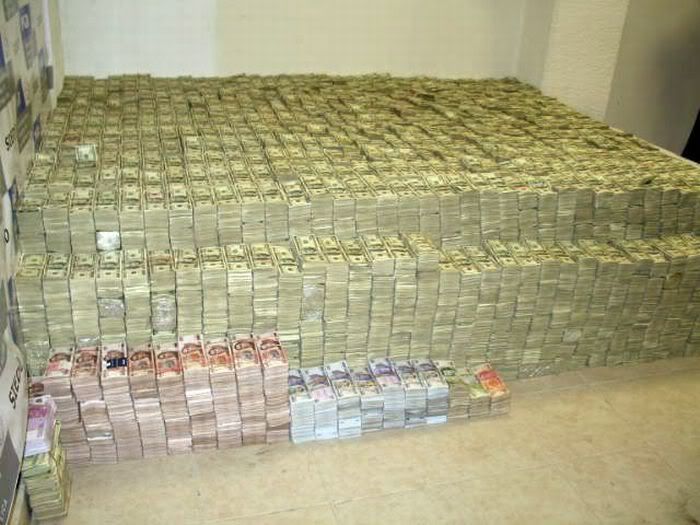
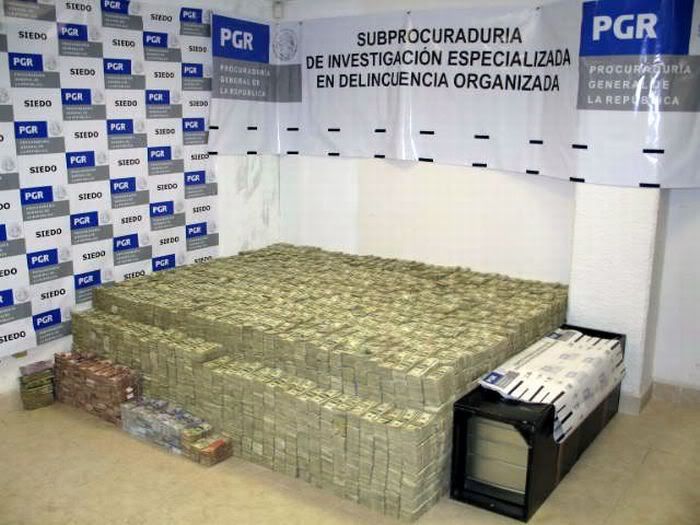
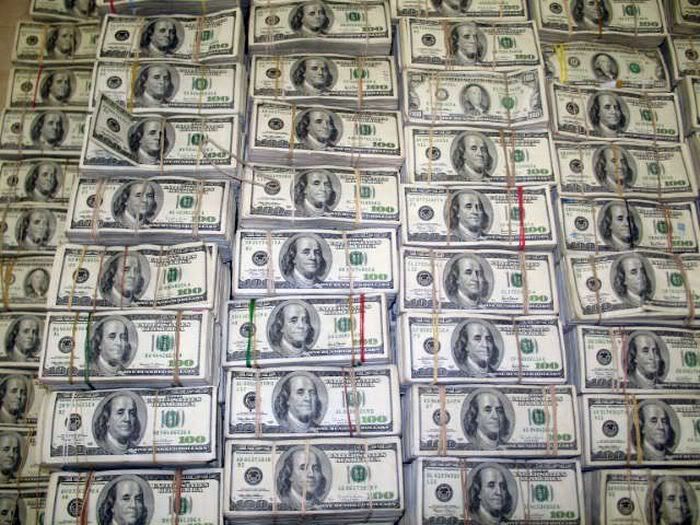
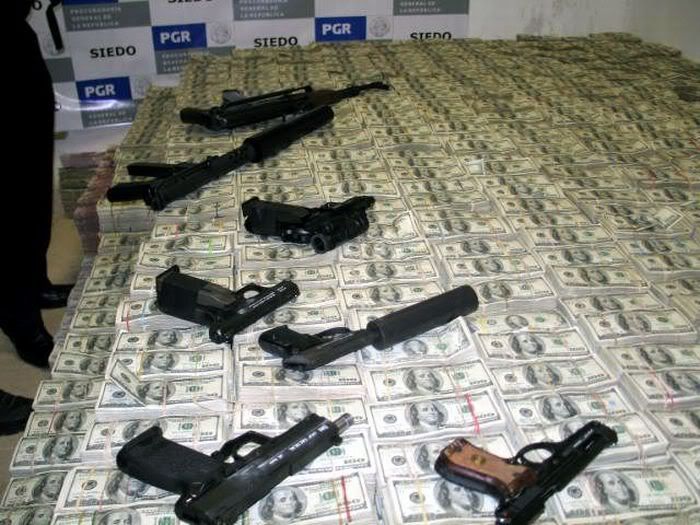
anyone want to guess how much that is, and lets assume the money we can't see is hundreds.
Quote: iamthepush
anyone want to guess how much that is, and lets assume the money we can't see is hundreds.
The AP reports that the 2007 bust in Mexico netted $205.6 Million USD.
Quote: AyecarumbaThe AP reports that the 2007 bust in Mexico netted $205.6 Million USD.
I was going to say 33 by 11, by 3 feet deep. Because it is not shrink wrapped it seems closer to 150 banknotes per inch than to 200. That would make it $196 million. In the neighborhood of 450 pounds of currency.
The federal reserve printed 10,000 stacks of $100 banknotes of equal size last fiscal year alone. Who knows how many of them are financing ruthless organizations around the world.
However, I think it is unconscionable for the European Union to print a 500 Euro note (worth about $700 today). In addition 35% of the total value of the banknotes in circulation are in the 500 Euro note. So there are much smaller stacks of currency in southern Spain, the gateway of most drugs into Europe.
Quote: pacomartinHowever, I think it is unconscionable for the European Union to print a 500 Euro note (worth about $700 today). In addition 35% of the total value of the banknotes in circulation are in the 500 Euro note. So there are much smaller stacks of currency in southern Spain, the gateway of most drugs into Europe.
Personally, I wish the US would:
1. Circulate $500 bills
2. Eliminate the $1 bill, in favor of a $1 coin, the same size as the Canadian Loony.
3. Eliminate the penny.
Why is it unconscionable for the European Union to print a 500 Euro note? I tend to doubt that is a major consideration in the illegal drug business.
Quote: WizardPersonally, I wish the US would:
1. Circulate $500 bills
Bound to happen sooner or later, especially if the government just keeps printing money.
Quote:2. Eliminate the $1 bill, in favor of a $1 coin, the same size as the Canadian Loony.
I agree the only way a dollar coin will be widely circulated is if the dollar bill is eliminated.
Quote:3. Eliminate the penny.
That will never happen.
Quote: WizardPersonally, I wish the US would:
1. Circulate $500 bills
2. Eliminate the $1 bill, in favor of a $1 coin, the same size as the Canadian Loony.
3. Eliminate the penny.
$500 bill sounds like a good idea.
Perhaps the energy consumed transporting (and minting) heavier coins should be calculated in the cost of getting rid of the 1$ bill. Of course, maybe that is offset by eliminating the penny.
Quote: NareedThat (eliminating the penny) will never happen.
It is just a matter of time. Already it costs more than a penny to make a penny. However, according to John Stossal at least, the zinc lobby squashes any talk of eliminating the penny every time it comes up.
Still, eventually they will be worth so little it will just be absurd to keep making them. I set the over/under for the date the Mint quits making pennies at 2026.
Quote: rxwinePerhaps the energy consumed transporting (and minting) heavier coins should be calculated in the cost of getting rid of the 1$ bill. Of course, maybe that is offset by eliminating the penny.
It is much more expensive making "paper" dollars, considering their much shorter lifespan than coins. The cost in fuel of lugging them around I think is negligible. We overweight Americans could use the additional exercise to carry around more metal in our pockets.
By the way, I put "paper" in quotes because they are not made of paper, but rather a mix of cotton and linen. That is why they don't get ruined when they go through the washer and dryer. Dang, that would have made for a good trivia question in the WoV trivia challenge yesterday.
Quote: WizardPersonally, I wish the US would:
1. Circulate $500 bills
2. Eliminate the $1 bill, in favor of a $1 coin, the same size as the Canadian Loony.
3. Eliminate the penny.
Why is it unconscionable for the European Union to print a 500 Euro note? I tend to doubt that is a major consideration in the illegal drug business.
I think it is a huge consideration. Cocaine and hundred dollar bills have a similar value per weight. If you smuggle cocaine you have to worry about the smell. If you are smuggling $100 banknotes you have to worry about the bulk, and you have to exchange the smaller banknotes for $100 banknotes. I think a big part of money laundering is getting the cash from one place to another where it can be converted.
A million dollar cash transaction involves something the size of a briefcase in US currency, but only a thick pocket billfold in �500 banknotes (about 3 pounds).
Now, I will grant you that there are high level government people who disagree. The EU defends its policy by saying that large banknotes don't cause crime, and people in Germany in particular were used to the big bills. There was a 1000DM banknote which is equivalent to a �500 banknote. The USA considered re-issuing the $500 banknote when the Euro currency came out, because they felt that the dollar would lose some of it's competitiveness.
The Canadian loonie is 7 g, diameter of 26.5 mm and thickness of 1.75 mm
The US presidential dollar is 8.1 grams diameter of 26.5 mm and thickness of 2.00 mm
So I don't see much advantage to the loonie over the US coin. But no government in the world prints a banknote as worthless as the American $1 bill. It is a huge waste of money and resources to print tons of these banknotes and then destroy them when they wear out in a little over a year. I mean Guatemala still has small banknotes, but their economy is so low that their biggest banknote is worth US$26.
The only practical solution to the penny is to make it worth 5 cents. The nickel is too expensive to mint as well as the penny, and the cost of producing and distributing all new coins will be outrageous. So the federal reserve should declare that banks will exchange 20 pennies for a dollar, and all the nickels will vanish into coin collections or be exchanged at banks. All the pennies will come out of tin cans and drawers. After that just keep minting the penny, but change the label from 1 cent to 5 cents. Authorize permission for stores to round up their bill totals to the nearest 5 cents. It will be confusing for a little while and some little kids will make out on their penny jars.
Quote: WizardPersonally, I wish the US would:
1. Circulate $500 bills
2. Eliminate the $1 bill, in favor of a $1 coin, the same size as the Canadian Loony.
3. Eliminate the penny.
Why is it unconscionable for the European Union to print a 500 Euro note? I tend to doubt that is a major consideration in the illegal drug business.
You should live in New Zealand. We have made good progress with "updating" our currency since introducing decimal currency (i.e. 100 cents = 1 dollar) in 1967:
Originally we had:
NOTES: $100, $50, $20, $10, $5, $2, $1.
COINS: 50c, 20c, 10c, 5c, 2c, 1c.
First we dropped the 2c and 1c coins. At the same time, the $2 and $1 notes became coins. That way all the cash registers didn't end up with wasted space for 2 unused coin trays. There is no rule that prices have to end in 0 or 5 cents - you can still charge any price. If paying cash, "Swedish Rounding" is applied: .01 .02 .08 and .09 round to nearest .00 and .03 .04 .06 .07 round to nearest .05 -- a break even proposition over time for cash payers!
Then we changed our notes from paper to plastic. Huge saving in longevity, heaps of added security features, and we made them smaller too. That's killing at least 3 birds with one stone!
Recently we dropped the 5c coin and at the same time down-sized the 10c, 20c, and 50c. These used to be some of the heaviest coins in the world, Australia still uses similar large coins. You can still charge any price in cents, and many stores now round any increment down to the nearest .00. Of course rounding is only done on a total price [not on each item] so the savings are minimal. Over half of all retail transactions here are now electronic anyway, which means the exact price can be charged.
So, lighter and fewer coins, plastic banknotes that don't get destroyed in the wash - it's mostly good! The only downside is that plastic banknotes don't lie flat after being folded, which means casino dealers [to bring this post back to gaming!] find them harder to lay out when cashing for chips.
Can't help with the $500 note though. It seems logical to introduce this but I don't think we ever will. I've read the argument elsewhere that it makes it harder for criminals to move large amounts, this is apparently why the largest UK note is only 50 pounds? Casinos are the only place where I tend to see a lot of $100 bills, but even there we have a law now that slot machines won't accept anything bigger than a $20 note. Of course the casinos got around that by using vouchers and bill exchangers - what a waste of time.
Still, 2 out of 3 ain't bad!
Bring on the $5 coin I say.
Quote: Wizard
2. Eliminate the $1 bill, in favor of a $1 coin, the same size as the Canadian Loony.
How ever will I tip strippers?!?
Quote: waltomealHow ever will I tip strippers?!?
Leave her guessing which time your hand will have a $5 bill in it?
Quote: algle
Recently we dropped the 5c coin and at the same time down-sized the 10c, 20c, and 50c. These used to be some of the heaviest coins in the world, Australia still uses similar large coins. You can still charge any price in cents, and many stores now round any increment down to the nearest .00. Of course rounding is only done on a total price [not on each item] so the savings are minimal. Over half of all retail transactions here are now electronic anyway, which means the exact price can be charged.
So, lighter and fewer coins, plastic banknotes that don't get destroyed in the wash - it's mostly good! The only downside is that plastic banknotes don't lie flat after being folded, which means casino dealers [to bring this post back to gaming!] find them harder to lay out when cashing for chips.
Can't help with the $500 note though. It seems logical to introduce this but I don't think we ever will. I've read the argument elsewhere that it makes it harder for criminals to move large amounts, this is apparently why the largest UK note is only 50 pounds? Casinos are the only place where I tend to see a lot of $100 bills, but even there we have a law now that slot machines won't accept anything bigger than a $20 note. Of course the casinos got around that by using vouchers and bill exchangers - what a waste of time.
Still, 2 out of 3 ain't bad!
Bring on the $5 coin I say.
So the smallest coin in New Zealand is 10 cents (8 cents American) and there are nobody gets upset with the rounding. Very sensible.
New Zealand, like Iceland issues a very small amount of currency, roughly 1000 NZD per capita (US$800). The 100NZD banknote is between 3 and 4 per capita, and the 50NZD banknote is between 4 and 5 per capita. So the 20NZD is the primary banknote of use.
It would be virtually impossible to start a large scale counterfeiting operation. People would notice if you tried to circulate the larger notes since there are so few in circulation, and it would take forever to circulate enough counterfeit twenties to make the operation worthwhile.
The circulation numbers of larger banknotes are so low, that any major criminal organization must work in foreign currency, diamonds, bearer bonds, all electronic transactions. Street transactions for prostitutes, heroin, and stolen goods are also difficult. Muggings and purse snatching also offers little return.
The ability to direct person to person electronic transactions using personal phones should be available in a few years. I suspect your government in limiting the banknotes acceptable to vending machines is thinking they may some day stop printing the 50 and 100 dollar banknote entirely. Then cash transactions will be for only the most incidental of purchases.
The UK has traditionally been wary of large banknotes since WWII. Operation Bernhard made such an accurate counterfeit pound note, that the government withdrew all of it's currency higher than the 5 pound note. They only re-issued the 50 pound note about 30 years ago and even today they are only circulating 3 banknotes per capita. But the UK issues roughly 1000 pounds per capita, nearly double the value of 1000 New Zealand dollars per capita.
Contrast that with my earlier figures that US is printing over 60 $100 banknotes per capita last fiscal year. But the per capita is almost meaningless since they are clearly meant to go overseas and into the foreign reserves of the world's central banks. Almost as a byproduct they finance the criminal organization and dictators of the world.
Quote: WizardIt is just a matter of time. Already it costs more than a penny to make a penny. However, according to John Stossal at least, the zinc lobby squashes any talk of eliminating the penny every time it comes up.
Still, eventually they will be worth so little it will just be absurd to keep making them. I set the over/under for the date the Mint quits making pennies at 2026.
Both pennies and nickels are money losing operations. Pennies are literally worth less than dirt (if you look at prices for good soil). Just transporting them around is ridiculous.
Nickels have a higher 'nickel' content than quarters or dimes. So they are running at production costs of around 7 or 8 cents.
If you redesign a nickel that is cheaper to produce, you need to make enough of them to replace the entire supply since the originals will immediately vanish into jars.
The only sensible thing is to make a penny worth 5 cents. That way the zinc lobby doesn't go bonkers, and you don't have to replace all the coins. You don't have to radically retool all the mints. The new pennies will just say 5 cents, and they won't make nickels anymore. There will be a handful of people with tubs full of pennies that will make out, but in the large scale it won't matter.
Quote: pacomartinBut no government in the world prints a banknote as worthless as the American $1 bill.
China's smallest bank notes are worth slightly less than 2 pennies.
The smallest denomination that is still in print today is the 1 RMB note, worth 16 cents and the biggest note available, 100 RMB, is worth roughly $15. Most shops in China use portable bill counting machines that can count stacks of bills and detect counterfeit notes. It is not uncommon to see people bring bags full of cash to buy a car or an apartment there.

However given all the quantitative easing done in the US and China's reluctance to keep supporting it I wouldn't be surprised if the RMB's value exceeds the dollar's in the near future. That million dollar stack won't look nearly as impressive if America goes through hyperinflation.
Mexico's smallest banknotes currently used is 20 pesos worth $1.67 .
Brazil's smallest banknote currently used is 2 rials and is worth $1.25 .
Japan's smallest banknote currently used is 1000 yen worth $12.38 .
As near as I can guess, both China and South Korea are extremely afraid of counterfeit operations and refuse to issue large notes. It is ridiculous burden on the economy to be using satchels full of cash.
The British government can get away with it because they have a highly developed system for electronic exchange. Exchange is 100 reminibi = £ 10. The bulk of their cash transactions are with the £20 note. They do have a £50 banknote, but they are only circulating three of them per capita. That's just enough to handle the used car business or the cheating husband's hotel bills.
I agree that it's time for the $500 bill to return. The lack of one isn't really making it any more difficult for the drug dealers, but it is making life more difficult for ordinary people that prefer cash.Quote: WizardPersonally, I wish the US would:
1. Circulate $500 bills
2. Eliminate the $1 bill, in favor of a $1 coin, the same size as the Canadian Loony.
3. Eliminate the penny.
Why is it unconscionable for the European Union to print a 500 Euro note? I tend to doubt that is a major consideration in the illegal drug business.
The mint/bureau has had a fight trying to eliminate the $1 bill. The SBA dollar was a flop because it looked too much like a quarter. That flop is partly to blame for the resistance to the new golden dollar coin.
>> the same size as the Canadian Loony.
The golden coin is the same size as the SBA dollar, so any vending systems that accept SBA will accept the gold coin. What size is a Loony?
Personally, I love the new coin. Then again, I nicknamed them "Parkway tokens" because the toll on the Garden State Parkway is $1. They used to have a token when the toll was less, but that was in the days before EZPass.
Inflation has to creep up a bit more before the penny gets eliminated.
Quote: WizardIt is just a matter of time. Already it costs more than a penny to make a penny.
You'd think then the government would love it more, yes?
But cost is only one issue. There are other ways to make a cheaper coin, up to making it out of plastic. The reason for the persistence of the penny is that enough people will want exact change
Quote:By the way, I put "paper" in quotes because they are not made of paper, but rather a mix of cotton and linen. That is why they don't get ruined when they go through the washer and dryer. Dang, that would have made for a good trivia question in the WoV trivia challenge yesterday.
Lately plastic bills are all the rage. In mexico the 20 and 50 peso notes are made of plastic now. Allegedly they last longer and resist abuse better. In practice I see a lot more torn plastic than paper notes.
An even better medium for printing bank notes would be silk. But the cost would be too high and counterfeiting would be easier. you can get silk easily, you can't get cotton-linen paper at all.
2026?Quote: WizardIt is just a matter of time. Already it costs more than a penny to make a penny. However, according to John Stossal at least, the zinc lobby squashes any talk of eliminating the penny every time it comes up.
Still, eventually they will be worth so little it will just be absurd to keep making them. I set the over/under for the date the Mint quits making pennies at 2026.
I'd put it closer to 2015.
Quote: HKrandomChina's smallest bank notes are worth slightly less than 2 pennies.
.[/q
The smallest denomination that is still in print today is the 1 RMB note, worth 16 cents and the biggest note available, 100 RMB, is worth roughly $15.
My last trip to China I think the smallest note I saw was 5 RMB. I'm not saying you're wrong, but everyone gave me 1 RMB coins. I've seen 1 fen (cent) notes my first trip in 1992. That would be worth about 1/6 of one penny. It was a tiny thing, about the size of two sticks of gum.
In China I don't fuss carrying anything less than 1 RMB coins. Once I passed a beggar with a hat for donations. I dropped a few jiao coins into it and they all bounced out and landed a few feet away. The beggar didn't even bother to retrieve them.
Sure you can, it costs one dollar for each pre-cut sample :)Quote:you can't get cotton-linen paper at all.
Quote: pacomartinThe British government can get away with it because they have a highly developed system for electronic exchange. Exchange is 100 reminibi = £ 10. The bulk of their cash transactions are with the £20 note. They do have a £50 banknote, but they are only circulating three of them per capita. That's just enough to handle the used car business or the cheating husband's hotel bills.
50 quid notes get used for bookmakers at the race track and cash-in-hand builders. Only two times I've ever seen 'em. Except the currency exchanges, when I always hand them back and ask for notes that are actually acceptable in the pub (sometimes I have to take them anyways and then get them changed in the first bank I see in the UK).
Quote: thecesspit50 quid notes get used for bookmakers at the race track and cash-in-hand builders. Only two times I've ever seen 'em. Except the currency exchanges, when I always hand them back and ask for notes that are actually acceptable in the pub (sometimes I have to take them anyways and then get them changed in the first bank I see in the UK).
The UK introduced the modern £50 banknote in 1981, ten years after decimalization. At the time a production of US $100 banknotes was about 4 per capita. Now after three decades the UK is still circulating roughly 3 £50 banknotes per capita, while the USA is doing production runs of over sixty $100 banknotes per capita.
I assume a cash-in-hand builder is someone who is trying to avoid income tax.


